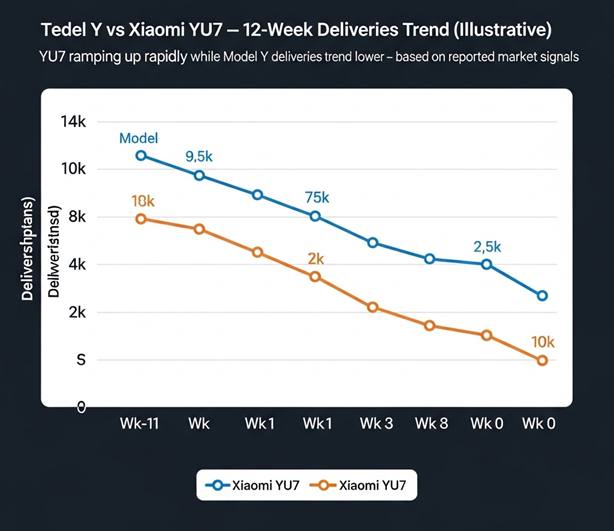For years the Tesla Model Y has been the electric vehicle to beat — the world’s best-selling EV and briefly the top-selling car overall. Now, in China, a bold new rival from an unexpected challenger is taking aim. Xiaomi’s YU7 launched with a bang, and the ripple effects are already showing up in registration and delivery data that suggest the Model Y is losing ground.

When Xiaomi unveiled the YU7 earlier this year, the company didn’t hide its target: the Model Y. The tech giant compared price and specs directly to Tesla’s refreshed crossover and promised a product that could out-compete at multiple levels. Buyers answered fast — more than 200,000 pre-orders poured in within minutes of the reveal. That kind of instant demand launched a backlog so deep that Xiaomi CEO Lei Jun publicly urged some buyers to consider competitors because deliveries won’t catch up for many months.
That mismatch — enormous pre-orders versus limited early production — created a strange market dynamic: pent-up demand on one hand, and a slowing volume for incumbents like Tesla on the other.
Insurance and delivery data from China, tracked by analytics firm ThinkerCar, show how the market shifted over the last three months. Xiaomi’s YU7 deliveries ramped up quickly — reaching more than 3,000 units per week in recent weeks as production expanded. At the same time, Tesla’s Model Y deliveries declined from their highs and remain materially below last year’s peak levels.
It’s reminiscent of the effect Xiaomi’s earlier EV, the SU7, had on Tesla’s Model 3 over the past year: the SU7 consistently outsold the Model 3 in China, and the Model 3 only briefly looked like it might be staging a comeback before slipping back into familiar patterns.
China is the world’s most aggressive EV marketplace. Local makers move fast on price, features, and factory scale without the same regulatory or market hurdles that automakers face elsewhere. Tesla benefitted massively from building Gigafactory Shanghai — a local production base that helped it scale quickly and offer competitive pricing. But local manufacturers, including Xiaomi, have closed that gap by leveraging domestic supply chains, software strengths, and aggressive pricing strategies.
Tesla’s early advantage is shrinking. Chinese firms learned from the outsiders and are now applying lessons and capital to produce vehicles that match — and sometimes outdo — Tesla on value.
Tesla faces a few clear options. First, the company could respond with price reductions and special incentive programs in China — a move that would blunt the YU7’s price appeal. Industry observers expect Tesla to consider trimmed-down Model Y variants or targeted price cuts to keep demand steady.
Second, Tesla can lean on the software and ecosystem advantages it touts: Full Self-Driving upgrades (where available), OTA feature rollouts, and charging network strengths. Those are long-game plays; price cuts are the short-term weapon.
Third, Tesla could accelerate production tweaks at Gigafactory Shanghai to get more cars out faster. The faster Xiaomi and others ramp, the more pressure Tesla will feel to match that pace.

Why buyers are scrambling
There’s a classic scarcity psychology at work: when buyers see “limited supply” plus the possibility of long waits, many rush to lock in orders. That’s exactly what happened when Xiaomi announced production timelines; the backlog encouraged even more people to pre-order, particularly early adopters who don’t want to be left waiting.
If you’re in the market for an EV in China (or watching global pricing), a few smart moves stand out:
- Don’t rush purely based on hype. Compare total cost of ownership, warranty and after‑sales support, and whether the charging and software ecosystems meet your needs.
- If immediate availability matters, a current in-stock Model Y or other available EV may be a better fit than waiting a year for a heavily backlogged new model.
- Expect prices to move. If Xiaomi can’t ramp production quickly enough, it’s possible Tesla will use price adjustments to keep potential buyers from switching.
This isn’t simply about two cars competing. The YU7’s success — and Xiaomi’s playbook of leveraging its brand, software, and pricing muscle — signals a broader shift: the future of EV dominance will look less like a few global champions and more like intense regional battles. For Tesla, the U.S. and European markets still matter immensely, but China’s fast movers can set price and product expectations that ripple globally.
If the YU7 continues to ramp and Xiaomi keeps dialing up deliveries, it could plausibly outsell the Model Y in China by year-end. That outcome would mark an important inflection point: a homegrown tech brand nudging a global EV icon out of pole position. But don’t write Tesla off. The company has a history of tactical price moves and product tweaks that can change the game overnight.
If you’re following EV news, the story to watch is no longer simply “Tesla versus the rest of the world.” It’s “Tesla versus agile, well-funded local challengers” in markets that move at lightning speed. Xiaomi’s YU7 is the latest reminder that in the EV era, product timing, production scale, software, and price combine to shape winners and losers — and China is where much of that contest plays out in real time.
Related Post
